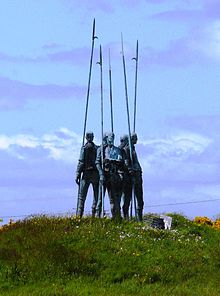Wexford Rebellion
| Wexford Croppie Pikemen | |

Society of United Irishmen
|
|
| Location | N25 road to New Ross |
|---|---|
| Designer | Éamonn O'Doherty |
| Material | Bronze |
| Completion date | 1998 |
| Dedicated to | 1798 Rising |
The Wexford Rebellion refers to the outbreak in County Wexford, Ireland in May 1798 of the Society of United Irishmen's Rising against the British domination of Ireland. It was the most successful and most destructive of all the uprisings that occurred throughout Ireland during the 1798 Rising, lasting from 27 May 1798 until about 21 June 1798. The Wexford Rebellion saw much success despite County Wexford not being thought of as an immediate threat by the government, because of the spontaneous risings that occurred both before and after the significant rebel victories in Oulart, Enniscorthy, and Wexford town.
The County Wexford Society of United Irishmen had remained relatively intact during the repression that saw much of the organisation in other counties severely weakened. However, in May 1798, just as the Rising broke out in County Kildare, the British arrested Anthony Perry of Inch, an ex-military officer and senior United Irishman. Perry was tortured, and named a number of people as United Irishmen leaders, including Bagenal Harvey. These were arrested.
News of the arrests and of the Massacre of Dunlavin Green in the next county, Wicklow swept through Wexford, and on the night of 26 May, rebels (known as Croppies for their short haircut) mobilised throughout north county Wexford and attacked military and loyalist targets for arms. The government rushed in troops, generally known as "Yeomen". Next morning the rebels gathered at Oulart Hill and Ballyminaun Hill. At Ballyminaun the rebels were crushed, but they won a significant victory at Oulart Hill, led by Father John Murphy and others, defeating a company of soldiers. On the way to Enniscorthy the Croppies increased their numbers to about 6,000. They won victory in Enniscorthy on 28 May, and two days later took Wexford town from one Colonel Maxwell. When the rebels entered Enniscorthy on 28 May they found that one of the leading merchants, William Barker, had been a Captain in Walsh's Regiment of the Irish Brigade in the service of King Louis XVI and had returned to the town to manage the family business on the dissolution of the Irish Brigade at the Revolution in 1798. They persuaded him to join them. Following the Battle of Three Rocks, the seizure of Wexford town and county on 30 May by the United Irishmen Insurgent forces under Colonel Thomas Cloney closed the first phase of the Wexford Rising and increased the rebels' numbers to 10,000.
...
Wikipedia
